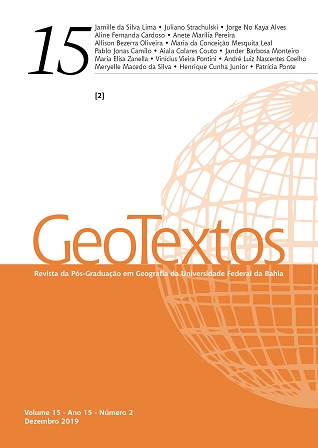URBAN PATHWAYS AS A WAY TO SEARCH AFROCRATENSE HERITAGE
DOI:
https://doi.org/10.9771/geo.v15i2.33877Keywords:
Spatial awareness, Architectural heritage, Crato-CEAbstract
Spatial awareness should be the main objective of teaching geography, whether in the academic or school environment, as a means of apprehending and transforming reality. Therefore, the study of the place is essential, as a space of daily living, where we can glimpse more strongly the social materiality. In this context, urban paths constitute an appropriate methodology for understanding the spatial consciousness-place relationship, as they allow the city to walk, glimpsing the essence-form of geographic objects. In the case of this work, we had as a contribution the relationship spatial awareness-place-black space, considering the architectural heritage forged through African construction techniques and African and African descent workforce in the city of Crato-Ce. Based on the African descent research (CUNHA JUNIOR, 2013), Africanities and African descent (CUNHA JUNIOR, 2001), associated with the methodology of urban pathways, we researched the Afrocratean heritage from architecture. We synthesized the results into three architectural examples, namely the old House Chamber and Jail, the free and traditional Fair and the São José Seminary. Thus, the urban paths, conditioned on the appropriate conceptual basis, promoted spatial awareness of the Afrocrat heritage, being relevant instrument of study of the urban space.Downloads
Downloads
Published
How to Cite
Issue
Section
License
Autores que publicam nesta revista concordam com os seguintes termos:
Autores mantém os direitos autorais e concedem à revista o direito de primeira publicação, com o artigo simultaneamente licenciado sob a Licença Creative Commons Creative Commons CC BY que permite o compartilhamento do trabalho com reconhecimento da autoria e publicação inicial nesta revista. Esta licença permite que outros distribuam, remixem, adaptem e criem a partir do seu trabalho, mesmo para fins comerciais, desde que lhe atribuam o devido crédito pela criação original. É a licença mais flexível de todas as licenças disponíveis. É recomendada para maximizar a disseminação e uso dos materiais licenciados. Ver o resumo da licença em: https://creativecommons.org/licenses/by/4.0/ Ver o texto legal da licença em: https://creativecommons.org/licenses/by/4.0/ Consulte o site do Creative Commons: https://creativecommons.org/licenses/?lang=pt
Autores têm autorização para assumir contratos adicionais separadamente, para distribuição não-exclusiva da versão do trabalho publicada nesta revista (ex.: publicar em repositório institucional ou como capítulo de livro), com reconhecimento de autoria e publicação inicial nesta revista.
Autores têm permissão e são estimulados a publicar e distribuir seu trabalho online (ex.: em repositórios institucionais ou na sua página pessoal) a qualquer ponto antes ou durante o processo editorial, já que isso pode gerar alterações produtivas, bem como aumentar o impacto e a citação do trabalho publicado (Veja O Efeito do Acesso Livre).






